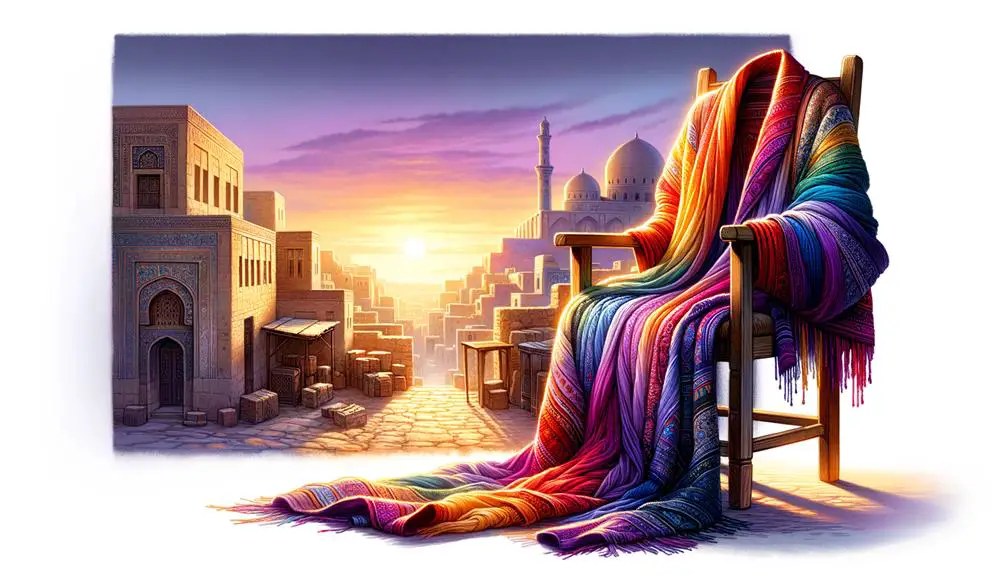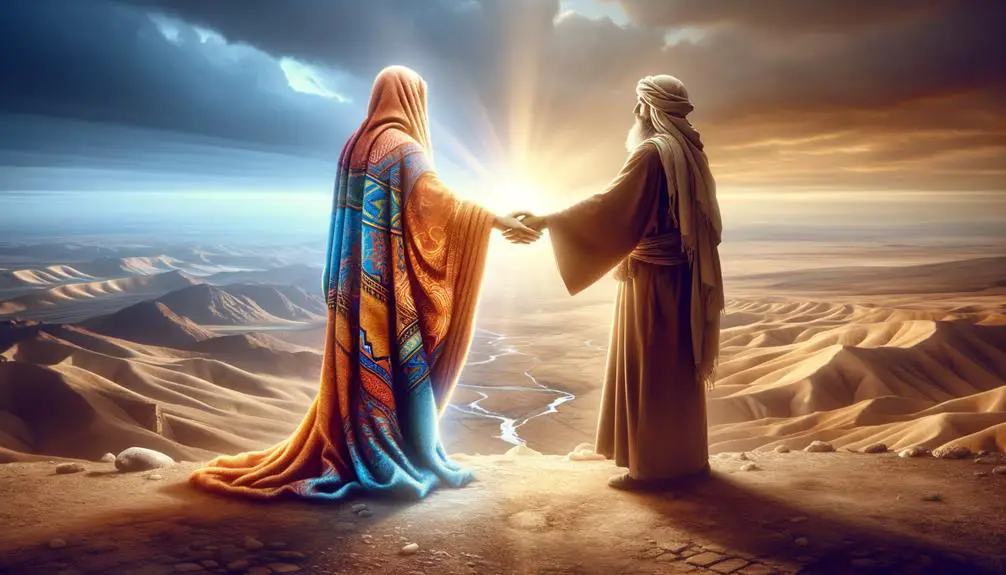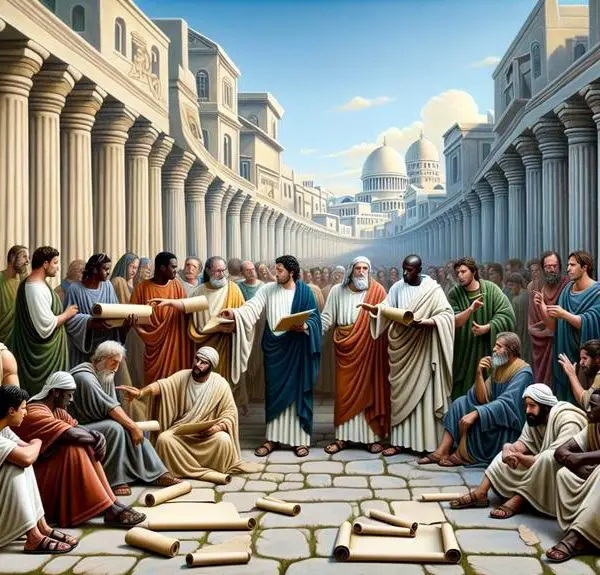A biblical symbol of favoritism, the coat of many colors was worn by Joseph, sparking envy and a journey filled with betrayal and redemption.

Who Had the Coat of Many Colors in the Bible
In the tapestry of biblical narratives, the vivid imagery of a coat of many colors stands out starkly against the often harsh realities of ancient life. You'll find that Joseph, the beloved son of Jacob, was the one adorned with this symbolic garment.
This wasn't just a fashion statement; it was a tangible sign of favoritism that ignited a fierce sibling rivalry, leading to events that would forever alter Joseph's life and, ultimately, the course of a nation.
As you explore this story, you'll uncover layers of betrayal, resilience, and redemption that resonate well beyond their historical origins, inviting you to ponder the complexities of family dynamics and the power of forgiveness.
Key Takeaways
- Joseph, Jacob's favored son, was the biblical figure who had the coat of many colors.
- The coat symbolized divine favor and marked Joseph as special among his siblings.
- Jacob's gift of the coat to Joseph fueled jealousy and rivalry among his brothers.
- The coat's significance extends beyond its vibrant colors, representing Joseph's unique destiny and challenges.
Joseph: The Beloved Son

Joseph, deeply cherished by his father, stands out as a central figure whose life story embodies themes of favoritism and redemption within the biblical narrative. You'll find that his journey is intricately linked with the ability of dream interpretation and the fulfillment of ancestral promises, elements that not only shape his destiny but also the course of his entire family.
Joseph's knack for dream interpretation plays a pivotal role in his tumultuous journey. Initially, it's his recounting of prophetic dreams, which suggest his future ascendancy over his family, that fuels his brothers' envy and sets the stage for his sale into slavery. Yet, this same gift becomes his salvation and a key to his rise to power in Egypt. It's through Joseph's interpretation of the Pharaoh's dreams that he's able to devise a strategy to save Egypt and surrounding nations from famine, thereby positioning himself as a figure of salvation.
The theme of ancestral promises is deeply woven into Joseph's narrative. His life story is a testament to the fulfillment of the promises made by God to Abraham, Isaac, and Jacob—promises of multiplication and blessing. Despite the trials Joseph faces, the covenantal promises to his ancestors remain steadfast, guiding him towards a path of reconciliation and the eventual establishment of Israel in Egypt. This not only underscores the faithfulness of God in the biblical story but also highlights Joseph's pivotal role in the continuation and realization of these ancestral promises.
Analyzing Joseph's life, you can't help but admire how dream interpretation and ancestral promises are central themes that underscore the complexity and depth of his character's journey.
The Gift From Jacob
Among the many pivotal moments in Joseph's narrative, the gift of a colorful coat from his father Jacob stands as a symbol of favored status and the catalyst for ensuing familial discord. This act of giving goes beyond a mere display of parental love; it underlines the complexity of human relationships and the unforeseen consequences of Jacob's generosity. Through his action, Jacob unknowingly sets in motion a series of events that would profoundly impact Joseph's life and the trajectory of the biblical narrative.
To better understand this moment, consider the following points:
- Jacob's generosity wasn't just about the material value of the coat; it was a tangible manifestation of his deep affection and preference for Joseph over his other sons.
- This gift was an extraordinary demonstration of parental love, highlighting the special bond between Jacob and Joseph, which was rooted in both personal affection and divine prophecy.
- The coat's uniqueness could have been perceived by Joseph's brothers as a sign of Jacob's unequal love, thus sowing seeds of jealousy and resentment.
- Jacob's decision to bestow such a gift upon Joseph reflects the complexities of family dynamics, where actions motivated by love can inadvertently lead to division.
- The act of giving the coat serves as a turning point, not only in Joseph's life but also in the unfolding of Israel's history, illustrating how personal relationships can influence larger historical narratives.
Symbolism of the Coat

Exploring the symbolism of the coat reveals deeper layers of meaning within Joseph's story, uncovering how this garment symbolizes divine favor, individual destiny, and the complexities of human emotion. The coat, with its myriad of colors, is not just a sign of Jacob's preference for Joseph but also a mark of distinction that sets Joseph apart, predestining him for greatness and trials.
The color significance in ancient cultures cannot be overstressed. Colors were often symbolic of status, wealth, and spiritual connections. In Joseph's case, the vibrant colors of his coat could symbolize a spectrum of divine qualities and promises.
Cultural interpretations further enrich our understanding of the coat's symbolism. Different societies assign varying meanings to colors, which can offer insight into how Joseph's coat was perceived by those around him.
Aspect |
Significance |
Cultural Interpretation |
|---|---|---|
Color |
Divine Favor |
Wealth and Status |
Design |
Individual Destiny |
Distinction and Separation |
Reception |
Human Emotion |
Envy and Admiration |
This table highlights the multifaceted symbolism of the coat, intertwining divine favor with the harsh realities of human emotion. The coat's colors not only denote a special status but also mark Joseph for a future that is both blessed and fraught with challenges. The cultural interpretations of color add layers of meaning, suggesting that the coat could have been viewed as both a blessing and a source of envy. Thus, the coat of many colors stands as a potent symbol in Joseph's narrative, encapsulating the divine, the destined, and the deeply human.
Sibling Rivalry Intensifies
As you explore the narrative, it's evident that envy acts as a catalyst for escalating sibling rivalry.
The gift of the coat not only signifies favoritism but also marks the beginning of harsh consequences for the family dynamic.
This scenario underscores the complexities of parental preference and its impact on sibling relationships.
Envy Sparks Conflict
The gift of the coat of many colors to Joseph by his father, Jacob, ignited a deep-seated envy among his brothers, intensifying existing sibling rivalry. This act not only amplified the competition for their father's affection but also revealed significant psychological impacts and complex social dynamics within the family.
Envy can disrupt familial harmony, leading to isolation of the favored child.
Sibling rivalry, when intensified, may escalate into more severe conflicts.
The psychological well-being of all siblings can be adversely affected.
Social dynamics within the family are significantly altered, impacting relationships.
Favoritism by parents can have lasting effects on children's self-esteem and interpersonal relationships.
Understanding these dynamics is crucial in analyzing the broader narrative and its implications.
Favoritism's Harsh Consequences
Favoritism within Jacob's family worsened sibling rivalry, leading to dire consequences that extended far beyond mere jealousy. This situation underscores the critical need for parental guidance to navigate the complexities of sibling relationships.
The coat of many colors, a symbol of Jacob's preferential treatment of Joseph, served not only to ignite envy among the brothers but also to illustrate the profound impact of cultural influences on family dynamics. In societies where inheritance and blessing carried significant weight, Jacob's actions inadvertently set the stage for a family rift.
This biblical narrative teaches that favoritism can fracture familial bonds and emphasizes the importance of equitable treatment by parents to foster harmony and understanding among siblings.
Betrayal and Sale

Joseph's brothers, fueled by jealousy and resentment, plotted his betrayal and eventual sale into slavery. This act wasn't just a spontaneous decision; it was a culmination of growing animosity towards Joseph, who wasn't only their father's favorite but also a dreamer of visions that implied his future dominion over them. The dynamics behind their decision to sell Joseph provide a fascinating insight into the complexities of human emotions and market dynamics of the time. Their initial plan was to kill him, but upon Judah's suggestion, they saw an opportunity to profit from their betrayal by selling him to a passing caravan of Ishmaelites heading to Egypt.
Analyzing this segment of Joseph's story, several key points stand out:
- Market dynamics: The brothers capitalized on the opportunity to sell Joseph to traveling merchants, indicating a rudimentary understanding of supply and demand. Joseph was a commodity in their eyes, and they leveraged the situation to their advantage.
- Dream interpretations: Joseph's dreams, which he innocently shared with his family, played a crucial role in the buildup to his sale. They were symbolic, yet his brothers interpreted them as threats to their status and future.
- Sibling rivalry: This is a prime example of how envy and competition can escalate to drastic actions.
- Moral ambiguity: The brothers' justification for their actions shows the complexity of human morality.
- Survival instincts: Despite their harsh actions, the narrative suggests a struggle with survival and familial bonds.
This episode in Joseph's life sets the stage for his transformation and the unfolding of his destiny in Egypt, without delving into the specifics of his journey there.
Joseph's Journey in Egypt
Upon arriving in Egypt, Joseph's story takes a dramatic turn as he moves from a position of enslavement to becoming a pivotal figure in Pharaoh's court. Initially sold into slavery by his brothers, Joseph's life seems to hit its lowest point. However, his exceptional ability in dream interpretation soon sets him apart. When the Pharaoh experiences perplexing dreams, Joseph's skill not only saves Egypt from a devastating famine but also marks the beginning of his economic ascent.
You'll find Joseph's journey in Egypt to be a testament to his resilience and wisdom. Despite his dire circumstances, he doesn't let despair dictate his actions. Instead, he utilizes his unique talents to navigate through his trials, ultimately leading to his rise to power. As the overseer of Egypt's granaries, Joseph's adept management ensures the country's prosperity, even in the face of seven years of famine.
This phase of Joseph's life highlights the importance of perseverance and the impact of possessing specialized skills like dream interpretation. His economic ascent from a slave to the second most powerful man in Egypt underscores the unpredictable nature of life and the potential for redemption and success against all odds.
Joseph's story in Egypt isn't just about his personal triumph but also about his contributions to the prosperity of a nation. It serves as a compelling narrative on the power of foresight, strategic planning, and the ability to turn adversities into opportunities. Through his journey, Joseph demonstrates that even in the most challenging circumstances, there's always a path forward for those who are prepared to seek it.
Reunion and Forgiveness

You'll find that the climax of Joseph's narrative revolves around the themes of reunion and forgiveness. His brothers' emotional reconciliation and Joseph's generous heart highlight the transformative power of forgiveness in mending fractured relationships.
This segment underscores the broader biblical message of reconciliation and the strength it takes to forgive those who've wronged us.
Brothers' Emotional Reconciliation
In the biblical narrative, the brothers' emotional reconciliation marks a pivotal moment of forgiveness and healing, showcasing the profound impact of unity and compassion within a fractured family. This moment serves as an exemplary case of emotional healing, akin to modern-day family therapy, where the essence of forgiveness plays a crucial role in mending relationships.
- Unity's profound impact on a fractured family dynamic
- The pivotal role of forgiveness in emotional healing
- Compassion as a catalyst for reconciliation
- The parallels between biblical reconciliation and modern family therapy
- The significance of emotional healing in restoring relationships
Analyzing this segment from an objective and knowledgeable standpoint reveals the timeless principles of reconciliation, unity, compassion, and forgiveness as essential components in the process of emotional healing within a family.
Joseph's Generous Heart
Building on the foundation of emotional reconciliation among siblings, Joseph's generous heart further exemplifies the profound significance of forgiveness and unity in healing fractured family relationships. His charitable actions towards his brothers, despite their past transgressions, underscore the heart's resilience and capacity for compassion.
Joseph's decision to provide for his family during famine, rather than seeking vengeance, highlights an important lesson: true strength lies in the ability to forgive and support one another in times of need. This narrative not only showcases the transformative power of forgiveness but also serves as a testament to the enduring bonds of family.
Through Joseph's example, we're reminded that even in the face of betrayal, choosing generosity can pave the way for reconciliation and a stronger, united future.
Legacy of the Coat
The legacy of the Coat of Many Colors transcends its biblical origins, becoming a symbol of favoritism and its consequences through generations. This unique garment, mentioned in the tale of Joseph, has woven its way through history, influencing both religious thought and cultural expressions. Its significance isn't just rooted in ancient texts but has evolved through modern interpretations and cultural adaptations. These reflections have shaped the way societies view favoritism, jealousy, and reconciliation.
To help you understand the multifaceted legacy of the Coat of Many Colors, consider these key points:
- Modern interpretations: Scholars and theologians continue to analyze the story of Joseph and his coat, drawing lessons about family dynamics and the impact of parental favoritism.
- Cultural adaptations: The story has been adapted into numerous plays, musicals, and movies, each bringing a unique perspective to the ancient narrative.
- Symbolism in art: Artists have depicted the coat in various forms, using it to explore themes of diversity, identity, and destiny.
- Psychological studies: The tale has been the subject of psychological research, examining the effects of favoritism on siblings and family structures.
- Educational tool: The story of Joseph and his coat is used in religious and moral education, teaching values such as forgiveness and resilience.
These aspects highlight how the Coat of Many Colors continues to resonate across different spheres, offering rich material for reflection and discussion. Its legacy is a testament to the enduring power of storytelling and its ability to illuminate the complexities of human relationships.
Frequently Asked Questions
How Has the Depiction of the Coat of Many Colors Been Represented in Art and Popular Culture Throughout History?
Throughout history, the coat of many colors has been depicted in art and popular culture with varying color symbolism and artistic interpretations. You've seen it evolve from Renaissance paintings to modern films, each reflecting the era's views on diversity and providence.
Artists have used vibrant colors to symbolize richness and favor, while contemporary interpretations often explore deeper themes of identity and family dynamics. This evolution showcases a fascinating blend of tradition and creativity.
Are There Any Archaeological Findings or Historical Evidence That Support the Existence of Such a Garment During the Time Period Joseph Is Believed to Have Lived?
You're diving into whether there's any concrete evidence for the famed garment from antiquity. Imagine discovering an ancient tunic through textile analysis, revealing vibrant dyes and complex weaving patterns. Such a find would be groundbreaking.
However, to date, no archaeological discoveries directly confirm the existence of Joseph's multicolored coat. But, textile analysis does show that richly dyed fabrics symbolized status, aligning with the cultural symbolism of wealth and power in ancient narratives.
How Do Various Religious Traditions Other Than Christianity and Judaism Interpret the Story of Joseph and His Coat of Many Colors?
In exploring Joseph's story, you'll find Islamic perspectives offer a distinct narrative, focusing less on the coat and more on his prophetic journey. Cultural adaptations across religions interpret the tale variably, highlighting universal themes of envy, redemption, and divine providence.
These interpretations enrich the story, allowing for a broader understanding that transcends religious boundaries. They reflect the story's ability to resonate across cultures, offering lessons in morality and faith.
What Psychological Interpretations Exist Regarding the Impact of Jacob's Favoritism Towards Joseph on Sibling Dynamics and Family Relationships in General?
You might find it intriguing that over 90% of siblings report experiences of rivalry.
Delving into the psychological interpretations, parental bias, like Jacob's favoritism, can significantly escalate sibling rivalry, affecting family dynamics deeply. This bias not only fuels competition for parental affection but can also imprint long-lasting effects on children's self-esteem and interpersonal relationships.
An analytical look suggests these dynamics offer insights into broader issues of favoritism and its impact on family cohesion.
In Modern Fashion, Have There Been Any Notable Designers or Trends Inspired by the Biblical Story of the Coat of Many Colors?
In modern fashion, you'll find designers and trends deeply inspired by color symbolism and advancements in fabric technology. They've creatively interpreted these elements, drawing parallels to the vivid narrative of the biblical story.
This inspiration is evident in collections featuring dynamic color palettes and innovative textiles, reflecting a blend of tradition and modernity. Analysts note how these designs celebrate individuality and diversity, mirroring the story's themes without directly referencing its origin.
Conclusion
In your life, much like Joseph, you may find yourself adorned with unique gifts that set you apart. His coat of many colors wasn't just fabric; it symbolized a destiny that transcended betrayal and sorrow. Your own 'coat' may lead you through trials, but it's also a beacon for your potential.
Joseph's story teaches that amidst life's coincidences and challenges, there lies a path to reconciliation and purpose. Remember, what seems like mere coincidence often weaves the tapestry of our legacy.



Sign up